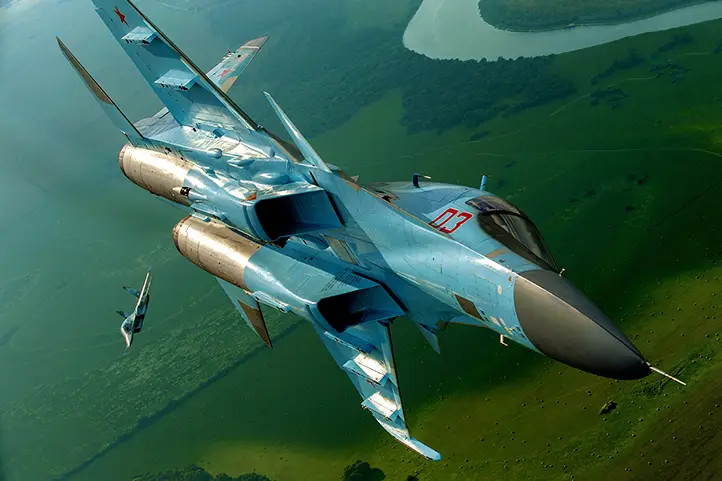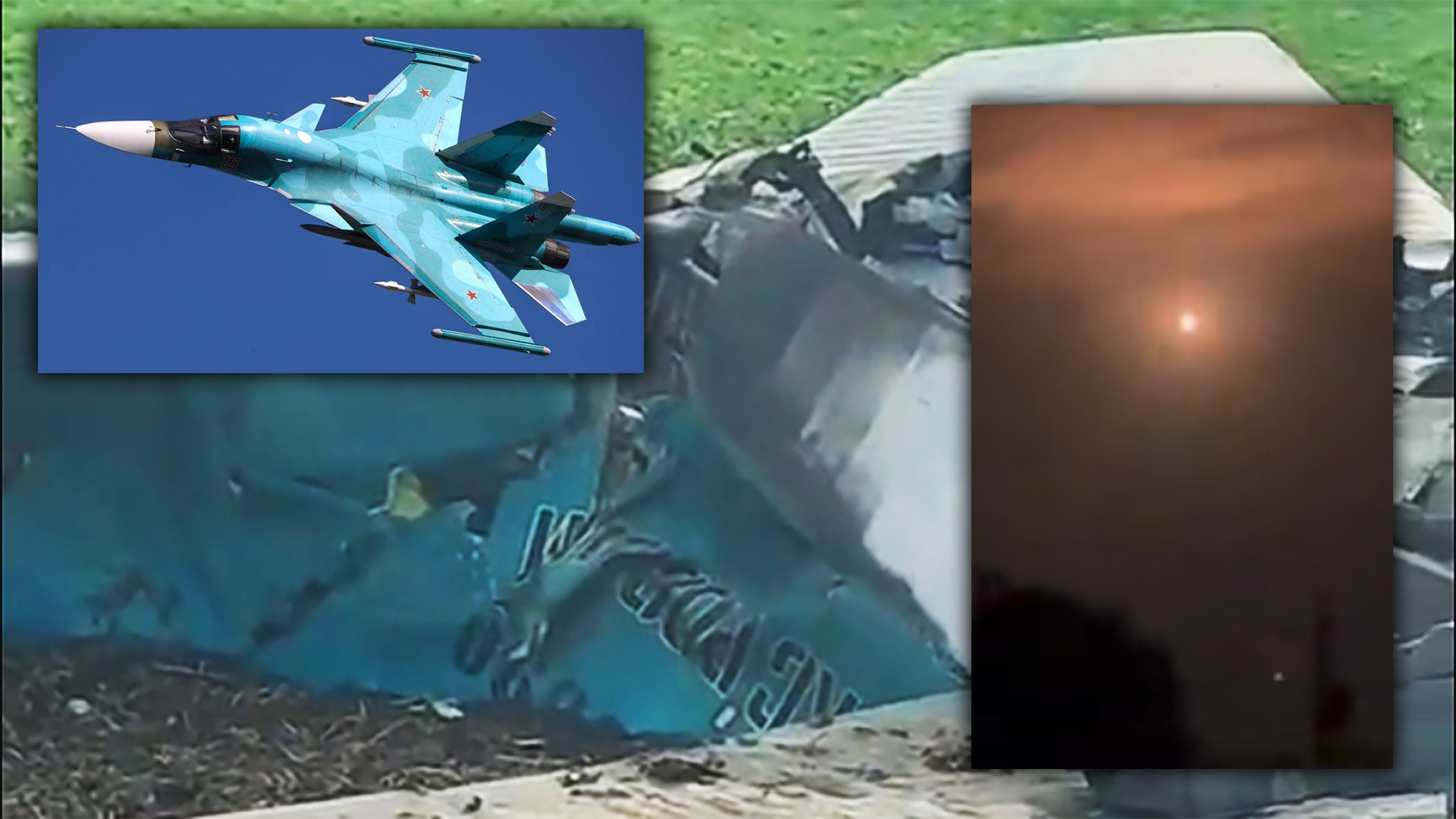Russian forces appear to have shot down one of their own Su-34 Fullback strike fighters as it flew over the occupied Luhansk region in eastern Ukraine.
Videos published online on July 17 show what are reportedly air defense systems belonging either to Russian forces or separatist proxies from the so-called Luhansk People’s Republic firing into the night sky, followed by a large fireball that floats to the ground.
Images posted online on July 18 show the resulting wreckage, identified as a twin-engine Su-34 fighter/bomber, which carries copious amounts of fuel that could be responsible for the large fireball. A portion of the jet’s tail number is visible in some of the images, leading the Dutch Aviation Society to conclude the aircraft is RF-95890, an advanced and rare Su-34M variant equipped with upgrades to its avionics, radar, and communications systems, as well as its electronic warfare and weapons systems.
The Su-34 is similar to the Su-27 Flanker from which it was originally derived, but is optimized as a strike fighter. Also known as the “Hellduck” or “Platypus,” it currently is flown exclusively by the Russian Aerospace Forces. The War Zone previously published an in-depth analysis of the Su-34’s unique capabilities, which readers can find here.
Russia has lost at least 35 fixed-wing military aircraft in Ukraine since the all-out invasion in February, according to researchers at the Oryx blog, which maintains an online tally of visually confirmed equipment lost in the conflict. The total number is likely much larger. Of those Oryx confirmed, 11 have been Su-34s, one of Russia’s most advanced strike aircraft. Most of those jets were lost to Ukrainian air defense systems and air-to-air missiles.

Five months into the war, Russian air forces have failed to establish air superiority over Ukraine. Shoulder-fired anti-aircraft missiles, formally called man-portable air defense systems, or MANPADS, fired by Ukrainians have downed dozens of Russian military airplanes and rotorcraft. Longer range systems have kept Russia’s manned strike aircraft out of the western part of the country and forced them into the MANPADS envelope near the front lines. Now, with NASAMS and IRIS-T SLM both set to arrive at some point, these numbers are likely to go up, or the effectiveness of Russian air power will continue to erode due to a lack of access to defended areas.
Friendly fire incidents are not all that rare in modern air combat. The U.S. and its allies have experienced tragic incidents before of this nature, but considering it is many months into the conflict, this loss seems especially avoidable.
We’re about to dive into all the other stuff that has happened over the past two days in and around Ukraine, but first, The War Zone readers can get caught up on our previous rolling coverage here.
The Latest
Russia has replenished its frontline units in the Donbas with Wagner Group private military contractors after recent heavy fighting, but even that group of mercenaries has had to lower recruitment standards to fill its ranks, according to the U.K. Ministry of Defense.
“Wagner has almost certainly played a central role in recent fighting, including the capture of Popasna and Lysychansk. This fighting has inflicted heavy casualties on the group,” the U.K. Ministry of Defense said in its latest intelligence assessment of the war in Ukraine.
The Wagner Group, the nucleus of which was formed by a portion of the “little green men” first employed by Russia in 2014 to seize Ukraine’s Crimean peninsula, is officially run out of Hong Kong. It recruits former military personnel from Russia and other former Soviet republics and has been employed in Syria, Africa, and elsewhere to further Moscow’s military goals while allowing the Kremlin a measure of deniability for their actions. Wagner has a less-than-stellar track record in Ukraine, where one of its superannuated former Russian air force pilots was shot from the sky and its main base in Luhansk was blown to smithereens.
Following the heavy fighting in Ukraine’s east over the past several weeks, Wagner has been depleted and has lowered its recruitment standards, according to the U.K. MoD. Convicts and formerly blacklisted individuals are now eligible to join up with Wagner, according to the U.K.’s assessment.
“This will highly likely impact on the future operational effectiveness of the group and will reduce its value as a prop to the regular Russian forces,” the U.K. MoD said. “This, at a time when a number of very senior Russian military commanders are being replaced, is likely to exacerbate grievances between the military and Wagner. It is also likely to impact negatively on Russian military morale.”
Fiona Hill, former U.S. National Security Council director for Europe and Russia and now a senior fellow at the Brookings Institution, told Foreign Policy in a recent interview that Russia’s recruitment efforts in some of its outlying regions, such as Buryatia in eastern Siberia and the far south region of Dagestan, is inspiring backlash to the war.
“There’s been an awful lot of Buryats sent to the front lines,” Hill said. “You start to see protests of women wanting their husbands and sons brought home. They’re starting to have a hard time recruiting in places like Dagestan, not so much as Chechnya, where there’s a lot of compulsion for people to fight in the war. Putin knows that this grind is having an impact.”
Putin is keen to conclude the conflict in some way that allows him to claim success to solidify his legitimacy before scheduled elections in 2024, Hill said. Putin was supposed to end his term then and allow a successor to enter office but has since extended his eligibility through 2036 when he will be in his 80s. He is willing to drag out the conflict in Ukraine until the West wearies of continuing to support Ukraine with weapons and other aid, she said.
“Putin wants to get this conflict over with,” Hill told Foreign Policy. “He wants to seem legitimate. He wants us to be the ones who feel that we don’t have time—when he also has a clock ticking. … Putin’s game is to have us defeat ourselves, basically, because we can’t imagine being able to sustain this over several years.”
The Institute for the Study of War (ISW) concurred with that analysis. In its latest take of conditions on the ground, the think tank said the Kremlin likely is launching a “long-term force regeneration effort” to rebuild its military for a long-haul campaign in Ukraine.
ISW reports very little movement on the frontlines in east Ukraine, though Russia’s military has awoken from an “operational pause” it took after the capture of Lysychansk.
The southern Ukrainian City of Mykolaiv was hit with at least 10 missiles, reportedly S-300 surface-to-air missiles, overnight. Using SAM systems as land attack weapons is unusual and their accuracy against specific targets is questionable, as they are designed to track and home in on overflying aircraft, not static targets on the ground. Mykolaiv’s mayor, Vitaly Kim, asserted earlier this month that Russia was using the S-300 to attack land-based targets, as The War Zone detailed at the time.
Also overnight, in a somewhat mysterious and roundabout incident, a cargo plane carrying weapons flown by Ukrainian pilots from Serbia to Jordan crashed in Greece. The cargo’s ultimate destination was reportedly Bangladesh. Few details are available as to the origin of the weapons or why they were being flown to Bangladesh. There is no indication that the shipment was illicit, but European Union and NATO officials in recent weeks have voiced concerns that Western weapons pouring into Ukraine could end up on the black market.
Ukrainian forces continue to target Russian ammunition depots with precision weapons donated by the U.S. and other NATO nations.
Loaded with Guided Multiple-Launch Rocket Systems (GMLRS), HIMARS has been effective at blowing up dozens of ammo dumps, up to 43 miles behind Russian lines.
Here is a nice visualization of the weapons and relative range in each adversary’s arsenal. The chart shows Ukraine’s slight advantage in reach, provided primarily by U.S. and NATO-supplied HIMARS and M270 tracked launchers, which fire the same munitions. Still, in terms of accuracy, HIMARS GMLRS rockets are in a class of their own compared to their Russian counterparts.
Ukrainian Defense Minister Oleksii Reznikov recently spoke with U.S. Defense Secretary Lloyd Austin, who “has some very good news,” presumably about new shipments of weapons to Ukraine, but shared no details.
Still, Ukraine’s artillery units are not clear of Russian long-range fire, as the below video demonstrates. M777 towed howitzers were some of the first artillery weapons the U.S. promised Ukraine but to employ them effectively, the cannon must be positioned within range of some of Russia’s indirect fire systems.
Ukraine’s effective use of precision munitions has helped slow Russia’s advance westward and the rain of artillery on Ukrainian forces’ heads, but heavy ground combat continues in Luhansk, as evidenced by the below video of Russian soldiers in a firefight with Ukrainian troops.
July 17 was the 8th anniversary of the downing of Malaysian Airlines Flight 17 by a Russian Buk surface-to-air missile. Ukrainian President Volodymyr Zelensky posted his thoughts on the matter on Twitter, blaming Russia for shooting down the civilian airliner, killing all 298 people on board. The Ukrainian Ministry of Defense likewise posted about the disaster, saying “the number of Russia’s victims is dramatically increasing up to dozens of thousands of civilians.”
Some of Ukraine’s Special Operations Forces took a few of their new Western-donated vehicles for a test drive recently. As seen in the video the soldiers posted below, these include a Polaris-type dune buggy and a four-wheeled all-terrain vehicle. “More mobility will help them to destroy more occupiers,” the Ukraine Ministry of Defense said. “We appreciate the support from our international partners.” Buggies have played a significant role in the fight against Russia’s invasion, which you can read about here.
While advanced weaponry like HIMARS and other Western-supplied military equipment tends to hog the spotlight, Ukrainian units are racking up hits with improvised gear. Several videos that popped up online show the effectiveness and accuracy of using relatively inexpensive and easy-to-use commercial drones to drop bomblets on sophisticated and costly-to-relace Russian military hardware. Using a single 82mm mortar round, a single Ukrainian troop can at least damage, if not destroy, a Russian infantry fighting vehicle or even a tank.
The DJI Matrice 300 RTK UAV armed with an 82mm mortar round is on the higher end of commercial drones but is available direct from the company for $13,700.
A smaller drone was recently used to attack Russian positions in Kharkiv, armed with what appears to be energy drink cans rigged to carry explosives.
In another somewhat amusing instance of battlefield jury rigging, Ukrainian soldiers were filmed operating a 23mm autocannon mounted to the bed of a large civilian truck. The funny part is that truck chassis originally was used to pump commercial aircraft lavatories.
Elsewhere, Ukrainian troops were seen operating a 30mm 2A42 Shipunov autocannon, likely stripped from a Russian armored vehicle and mounted on a homemade tripod.
Video below supposedly shows Ukrainian soldiers using an MT-12 Rapira anti-tank gun. The MT-12 is a Soviet smoothbore 100-mm anti-tank gun, used by the Soviets between the 1960s and 1980s, but commenters seem to think the weapon in the video is instead a World War II-era D-44 85mm divisional field gun — dating from World War II — being used as an indirect fire weapon. This would hardly be the first time an antique weapon was used in the conflict. Rolling out such antique weapons underscores the importance of artillery in the current conflict, where much of the combat consists of the two sides lobbing long-range rounds at one another.
We will continue to update this post until we state otherwise.
Contact the author: Dan@thewarzone.com
